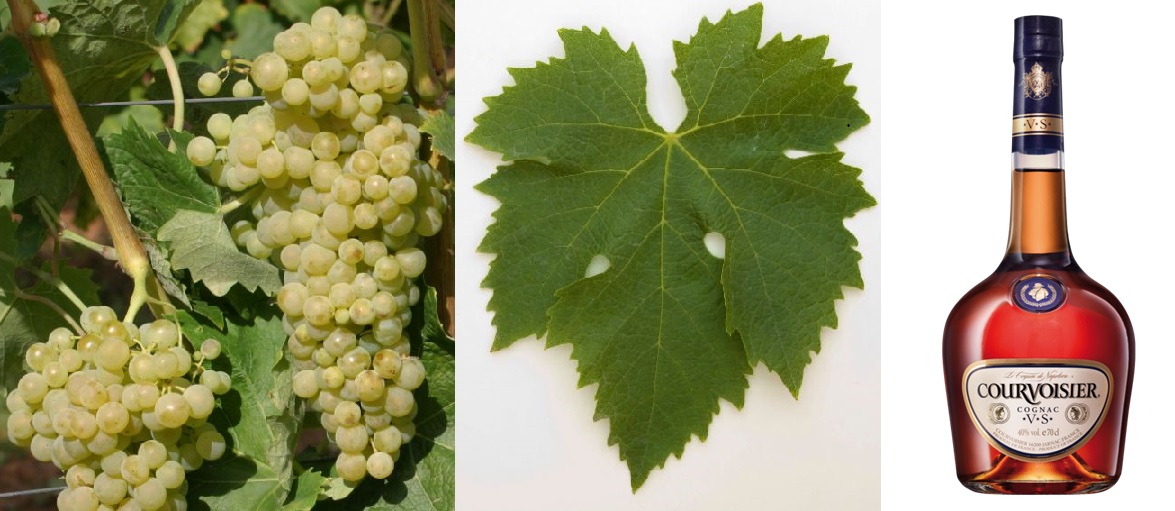The white grape variety originates from Italy. There are around 120 synonyms that indicate the vine's great age and wide distribution. Some of these, grouped alphabetically by country, are Ugni Blanc (Argentina); White Shiraz (Australia); Ugni Blanc (Bulgaria); Regrat (Germany); Armenian, Blanc de Cadillac, Chauche Gris, Clairette à Grains Ronds, Clairette de Afrique, Clairette de Vence, Clairette Ronde, Gredelin, Morterille Blanche, Muscadet, Muscadet Aigre, Rolle, Roussan, Saint Émilion, Saint Émilion des Charentes, Ugni Blanc = second main name (France); Balsamina Bianca, Bianca di Poviglio, Bianchello, Bianchetto, Biancone, Botticino Bianca, Brocanico, Buzzetto, Lugana, Morbidella, Procanico, Procanico dell'Isola d'Elba, Romani, Rossola, Rusciola, Senese, Sinese, Spoletino, Trebbiana Fiorentina, Trebbianello, Trebbiano della Fiamma, Trebbiano di Cesena, Trebbiano di Empoli, Trebbiano di Lucca, Trebbiano di Toscana, Trebbiano Fiorentino, Trebbiano Perugino, Uva Bianca (Italy); Rossola Brandcina, Rossola Brandisca (Corsica); Rogoznička, Šijaka, Ugni Blanc (Croatia); Branquinha, Alfrocheiro Branco, Douradina Branco, Douradinha, Douradinha dos Vinhos Verdes, Douradinho, Espadeiro Branco, Padeiro Branco, Tália, Thalia (Portugal); Uni Belyi (Russia); Ugni Blanc (Uruguay); St Emilion, White Hermitage (USA).

Parentage (parentage)
Despite seemingly suggestive synonyms or morphological similarities, it should not be confused with the varieties Albanella, Biancame, Douradinha, Maceratino, Passerina, Coda di Volpe Bianca, Damaschino, Erbaluce, Fernão Pires, Macabeo, Sémillon, Trbljan, Trebbiano Spoletino or the many other Trebbiano varieties. According to DNA analyses, there is a genetic link with the Alionza variety and possibly a parent-offspring relationship with the Garganega variety. However, the exact parentage is unknown. Procanico (Umbria) is considered a small-berried variety. A mutation is Ugni Blanc à Feuille Decoupée (Ugni Blanc à Feuilles Persilées). Trebbiano Toscano was a crossing partner of the new varieties Chenel, Folignan, Manzoni Rosa, Nouvelle, Rami, Select and Vidal Blanc.
Origin & characteristics
As the name suggests, the variety originates from Tuscany, where it was mentioned by the agronomist Giovanni Soderini (1526-1596) in his posthumous work published in 1600 together with a Malvasia (probably Malvasia Bianca Lunga) as the most widespread varieties in the region. It was introduced to France as early as the 14th century and is known there as Ugni Blanc. The medium to late ripening, high-yielding vine is resistant to powdery mildew and botrytis, but susceptible to downy mildew and eutypia. It produces low-alcohol, high-acid white wines with a neutral flavour that are ideal for distillation. The variety is grown worldwide under various names.
Cultivation areas
In Italy, the variety is cultivated inthe regions of Abruzzo, Emilia-Romagna, Lazio, Lombardy, Sardinia, Tuscany, Umbria and Veneto. It is authorised in numerous DOC/DOCG white wines there. These include Aprilia, Arborea, Bianco Capena, Bianco di Custoza, Bianco di Pitigliano, Capriano del Colle, Colli Albani, Chianti, Est! Est!!! Est!!! di Montefiascone, Frascati, Gambellara, Lugana, Maremma Toscana, Montecompatri-Colonna, Monteregio di Massa Marittima, Montescudaio, Orcia, Parrina, Romagna, Soave, Torgiano and Trebbiano d'Abruzzo. The area under vine in Italy totals 35,441 hectares.
It was introduced to France from Italy as early as the 14th century during the papacy in Avignon (between 1335 and 1430), first in Provence and Languedoc and later in the departments of Charente and Charente-Maritime in south-west France. However, its name rarely appears on a label, as it mainly forms the basis for Armagnac under the name Ugni Blanc and for Cognac under the name Saint-Émilion, but is also used for the Côtes de Gascogne country wines, among others. The area under vines in France totals 78,842 hectares.
There are other areas in Europe in Bulgaria (738 ha), Greece (211 ha), Croatia, Moldova (277 ha), Portugal (122 ha), Romania (3 ha), Russia (66 ha) and Spain (49 ha). Outside of Europe and overseas, there are populations in Argentina (1,622 ha), Australia (14 ha), Brazil (231 ha), China (1,500 ha), India (300 ha), Canada (2 ha), South Africa (156 ha), the USA (primarily California (88 ha)) and Uruguay (682 ha). In 2016, the variety occupied a total of 120,343 hectares of vineyards, with a strong long-term downward trend. In 1990, there were still over 200,000 hectares. This puts the Trebbiano Toscano variety in 11th place in the global grape variety ranking (Kym Anderson).
Source: Wine Grapes / J. Robinson, J. Harding, J. Vouillamoz / Penguin Books Ltd. 2012
Grape and leaf: Ursula Brühl, Doris Schneider, Julius Kühn-Institut (JKI)
Cognac bottle: Courvoisier
Voices of our members

As honorary chairman of the Domäne Wachau, it is the easiest and quickest way for me to access the wein.plus encyclopaedia when I have questions. The certainty of receiving well-founded and up-to-date information here makes it an indispensable guide.
Hans-Georg Schwarz
Ehrenobmann der Domäne Wachau (Wachau)